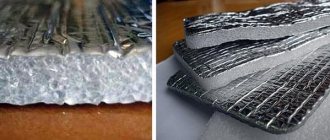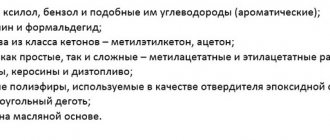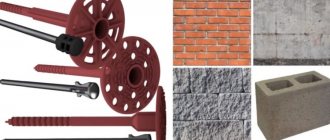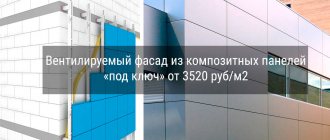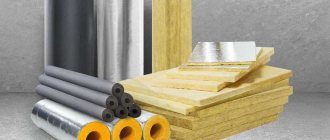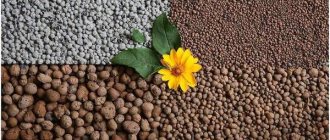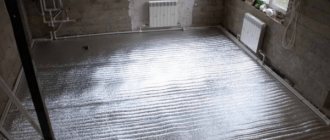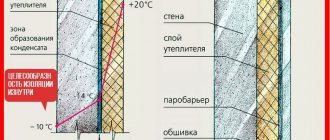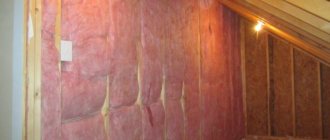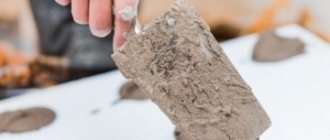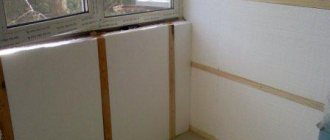Thermal insulation qualities of Penofol
It should be noted that when compressed to 2–3 times the original thickness, air is partially displaced from the material, and the thermal conductivity coefficient increases significantly.
At the same time, reducing the thickness of the layer leads to a proportional decrease in heat transfer resistance. This means, at least, that Penofol, as insulation, should not be used in a compressed state. On the manufacturer's website you can find the following values:
heat transfer resistance R of PENOFOL insulation in a structure with a closed air gap is 1.175 – 1.362 m2C/W.
Apparently, such a high value for a thin layer of insulation was obtained by adding up the heat transfer resistance of directly foamed polyethylene with a thickness of 5 - 10 mm - only 0.15 - 0.3 m2C / W, and also by adding here the heat saving from foil (a barrier for radiant heat), which completely depends on the radiation power from the inside, the temperature in the room, the presence of heating sources, the degree of absorption of radiation by structures, and also, apparently, adding the resistance of the “closed air gap” of the structure, which can actually reach 1.0 m2C/W, for example, in a double-glazed window.
However, the obvious fact is that Penofol really does insulate, all that remains is to apply it correctly.
User reviews about Penofol
It must be admitted that on popular forums there are quite a variety of responses and opinions of homeowners about reflective polyethylene insulation. We would venture to assume that the negative or positive in the comments depends on the correct use of the material.
Let's give a few examples, discarding obviously purchased reviews:
Vyacheslav, Donetsk, Ukraine.
Recently, for the purpose of repairs, I had to open the plasterboard lining of the wall inside the room. Behind it was foil-coated Penofol covering a plastered cinder block wall. There was dampness and black mold under the insulation; all the sheathing had to be dismantled and the walls dried.
Ivan, Veliky Ustyug, Russian Federation.
I lined a cold veranda made of plank with 5 mm Penofol. I stapled it to the walls and ceilings, laying down sheets of chipboard. This winter I calmly opened the door to the veranda, without fear of freezing the house; the temperature outside was minus 40 degrees. Sometimes he heated the extension with a potbelly stove to dry the walls.
Natalia, Lipetsk, Russian Federation
No matter how they insulated the northern wall of my private house, it was impossible to get rid of the mold. We tried cotton wool, polystyrene foam, all kinds of waterproofing. My father-in-law, a builder, came to visit, remodeled everything and covered it with this shiny material. The result after opening (a year later) is that the wall is dry.
While looking for video material to publish, we came across an interesting point that confirmed our assumptions. Installers are well aware of the recommended methods of using Penofol, but in practice the technology is constantly being violated. The reason is clear: installing double lathing for the sake of a thin layer of insulation is not economically feasible. It would be better to install full-fledged thermal insulation from basalt wool or Penoplex on the subsystem without any frame.
Advantages and disadvantages
The main advantage of any insulation with a foil layer is its technical performance, which is significantly increased compared to similar materials, but without a foil layer. However, due to additional production costs and complicated technology, such a heat insulator is more expensive. In general, foil insulation has a lot of positive qualities.
Insulation with foil is significantly superior to conventional heat insulators
Advantages of the material:
- sound insulation;
- safety from an ecological point of view in most species;
- resistance to temperature changes;
- moisture resistance;
- easy installation;
- high thermal insulation properties;
- durability.
Pros and cons of foil insulation
The disadvantages of the material include softness, which prevents the use of foil insulation when laying some soft types of floor coverings, as well as high cost compared to ordinary thermal insulation materials.
Advantages and disadvantages
Like any solution in the field of thermal insulation, penofol has certain advantages
They are the first thing consumers consider when looking for an effective insulator. Positive characteristics:
- The versatility of the material. It is actively used for work during the construction of facilities and during repairs. It is often used as the main insulation to improve the performance of balconies.
- Minimum thickness. Low values of this parameter do not affect the insulating properties in any way. For example, penofol with a double-sided foil coating 4 mm thick is an excellent replacement for an 8.5 cm mineral wool layer.
- Easy installation procedure. The absence of difficult moments during installation allows you to avoid purchasing special tools. To cut the fabric, you can use a regular knife. For reliable fastening, a regular furniture stapler, tape or small nails are suitable.
- Penofol is an environmentally friendly material. The components that are used to create it are often used for food storage. Some companies producing this solution claim that it is able to provide protection against radiation.
- High fire safety. This insulation will never cause a fire, since it is classified as a low-combustible material.
- Rodents are indifferent to this heat insulator.
- Ease of transportation. Penofol is produced in the form of rolls. They are easy to place even in the luggage compartment of a car.
Although penofol has many advantages, it is still not without its disadvantages. One of them is excessive softness. This feature imposes certain restrictions on use: the material cannot be used for thermal insulation of walls under plaster or wallpaper; in some cases, a special adhesive composition is required for fastening (this disadvantage is absent if the consumer has chosen self-adhesive insulation for the work).
Nuances of foam installation technology
Thermal insulation construction with penofol provides a preparatory stage and selection of the necessary tools. The condition of communications and the structure itself is first checked. If there are grooves or other defects on the base, they need to be repaired with putty. There should be no dust or dirt on the surface. It is thoroughly cleaned with sandpaper.
Tools and materials
To insulate a structure with the specified material, the following tools are required:
- building level, knife, tape measure;
- stapler and staples;
- spatulas;
- marker;
- electric drill;
- screwdriver;
- sandpaper.
Dowels are often used to secure the material. During preparation, a primer must also be applied to the base. If the base is wooden, then it requires additional antiseptic and fire retardant treatment.
Insulation of house walls from the inside
Insulation of walls from the inside is carried out in the following order:
- Making a frame from wooden slats. In this case, a space of 2 cm should remain on both sides of the penofol. Thus, the effect of the insulation will be maximum. The sheathing must be secured using dowels. The pitch between the slats is 1 m.
- Insulation of electrical wires. The aluminum foam layer has a high level of electrical conductivity.
- Fastening the material. A furniture stapler and staples are used for fixation. Strips of the required width or length are cut with a construction knife. To improve the thermal insulation properties, the seams between the elements are taped with masking tape. It is not recommended to lay strips overlapping.
After the insulation is secured, the wooden frame is reinstalled. Chipboard or MDF can be fixed on it for subsequent finishing.
External wall insulation
To insulate a house from the outside, it is better to use a perforated type of material. It not only provides good insulating properties, but also helps remove steam from the room. Exterior finishing is done if there is no desire to change anything inside the building. Work should be carried out in warm weather on a dry base. Installation involves the following steps:
- Treating walls with antiseptic.
- Making a wooden frame. Self-tapping screws are used for fastening.
- Laying the insulation while maintaining a two-sided gap of 2 cm. The joints are connected with metallized tape.
Now you can make another wooden frame and begin finishing the building.
Ceiling insulation
Installation of insulation on the ceiling is carried out in the following sequence:
- Fastening the frame from wooden planks or metal profiles. Dowels are used for fixation. The step between elements is 1 m.
- Preparation of penofol fragments. There is no need to cut a large number of strips at once, since the ceiling area may have deviations.
- Fastening the material. The first strip is nailed onto the frame close to the wall. In this case, the foil side should be facing inside the room.
- The remaining fragments of penofol are laid end to end. All seams are covered with foil tape.
Chipboard sheets can be mounted on top of the material and the surface can be finished.
Floor insulation
Penofol is used as an insulating layer when arranging floors, as it is unpretentious in installation and operation. The base does not require special preparation. It needs to be smooth, clean and dry. The insulation must be laid so that there is a ventilation gap between the surface and the material. This will make it possible to avoid condensation.
Penofol must be secured with glue or double-sided tape. The use of a construction stapler is permitted. As in previous cases, the insulation strips are mounted end-to-end, and the seams are connected with metallized tape. The foil should “look” inside the rooms.
So, penofol is a new generation of insulation that provides a high level of insulation not only from heat loss, but also from noise and moisture. At the same time, the material consumption is relatively small. However, you need to choose the material correctly.
Installation
Wall treatment from the inside
Wall insulation with penofol is done using self-tapping screws or a stapler.
For interior work, one-sided penofol with a thickness of 4–5 mm is used. You can also use double-sided, but its installation is different, since it is necessary to maintain an air gap on both sides. In ordinary apartments and houses, one-sided material is sufficient, but if the walls are too cold, then they should be additionally insulated with polystyrene foam or cotton wool.
Our instructions will help you understand how to insulate a wall with penofol from the inside:
- We roll out the roll of insulation and cut off a strip equal in length to the length of the wall;
Cut the strip to the required length.
- Starting from the ceiling, we nail the strip to the wall with a stapler;
Carefully attach the insulation strip.
- If the wall is wooden, you can also use a screwdriver. We put large washers on the screws, like on umbrella-type dowels;
We put washers on the screws.
- If the wall is concrete and it is impossible to nail the material to it with staples or screws, use glue;
- We cover the entire wall with penofol end-to-end, without making any overlaps;
We cover all walls without overlaps.
- We glue the joints with aluminum adhesive tape;
We glue the joints with aluminum tape.
- On top of the insulation we place a lathing made of slats or plywood with a thickness of at least 1.5 - 2 cm;
We fill the crate on top.
- We install plasterboard, chipboard or other sheathing on the sheathing.
We stuff the casing on top.
Important! On the side of the foil coating, be sure to leave an air gap 1.5–2 cm thick, otherwise condensation will accumulate on the surface. If the material is double-sided, the gap must be maintained on both sides.
Ceiling and floor
Insulating the ceiling with penofol significantly increases the energy efficiency of the room.
Installation of material on the ceiling is not fundamentally different from similar work on walls.
First, the material is cut, the desired strip is taken and attached along the wall, starting from the middle:
We mount the strip from the middle along the wall into the corner.
We reach one corner, nailing the side closest to the wall:
We fasten one side.
Then from the middle we move in the opposite direction, attaching the strip further:
One side of the strip is nailed.
Next, from the middle point we move perpendicular to the foam sheet and shoot at the line indicated in the photo in green:
We nail the middle line.
Next, we move from the middle to the corners, smoothing and shooting the material towards the ceiling:
We finally fasten the strip.
Similarly, you can insulate the floor with penofol or insulate the loggia. The main thing to remember is the basic rule: leave a gap between the casing and the foil!
Advice! In the case of a loggia, penofol should be used together with expanded polystyrene, since the balcony structures are too thin for serious thermal insulation.
During floor insulation work, the material is placed with the foil facing up. We glue the insulation to the screed or floor slab with any glue suitable for such substances. Then we lay logs on the carpet, on which we mount floorboards or plywood.
When using double-sided material, it is usually placed in the joist space so that there is an air gap on both sides. To do this, you can nail the carpet to the joists in the middle of the distance from the floor to the upper plane, then throw the material over the slats, and fasten it on the other side as well.
Then the insulation is stretched in the middle of the space, between the floor and the boards.
In addition, do not forget to attach the strips end-to-end, and treat the joints with aluminum tape. The material is soft and pliable, making it easy to cover curved and curved areas of walls. The low weight of the coating does not create any noticeable additional load on the structure.
Penofol pros and cons
Insulation with penofol is easier to perform, and due to its smaller thickness and high thermal insulation characteristics, the material has received many positive reviews from users.
What is penofol?
Penofol is know-how in the world of materials for insulating wooden houses, loggias and baths. It refers to reflective insulation with a top layer of special polished foil material. The base is foamed PVC. The heat-saving properties of the material depend on the density, thickness and quality of the foam base. The foam base has a thickness from 2 to 40 mm. The most common for insulating a wooden house inside is 10 mm. The 40 mm material is used only in the northern part of Russia, where the climate is very harsh. On top (on both or one side) foil is welded to the material, which is polished to a reflectivity of 97%.
A little bit of history
The material was invented in the USA and was used to produce spacesuits
In Russia, they paid attention to the high thermal insulation properties of the material and began to use it in the construction industry. For insulation of wooden houses, the material is used both inside and outside.
Insulating a wooden house from the inside with penofol is similar in design to a thermos. A wooden house, the walls of which are covered with foil thermal insulation, retains heat in winter and cool air in it in summer. At the same time, the internal insulation does not block the supply of oxygen to the tree, and the house does not stop breathing. And the thickness is several tens of times smaller than mineral wool or polystyrene foam, which made it possible to use insulation in the smallest rooms.
About the advantages and disadvantages of the material
Insulation can be used in combination with other materials or independently. And its lightness allows you to easily carry out insulation with your own hands alone. Positive reviews about penofol insulation are associated with its advantages:
- Environmentally friendly. The material is made of film and foil, which are used in the food industry. Some sources claim that it is capable of blocking radiation, but this fact has not been proven.
- Greater thermal insulation with a smaller layer thickness. According to scientific research, penofol with double-sided foil 4 mm thick is comparable in its thermal insulation properties to 10 cm mineral wool, 4 cm expanded polystyrene and 18 mm wood.
- Since the material does not allow steam to pass through, installation can be carried out without additional thermal insulation of the structure.
- It does not allow moisture to pass through or absorb, therefore it does not spread rot and mold on the wood.
- It has high soundproofing qualities, so it is used in frame construction for finishing children's rooms and bedrooms.
- It does not crumble or break; you can cut it with simple scissors or a sharp knife.
- Easily mounted on wooden walls of the house using small nails, construction foil tape or a stapler.
- It does not burn, as it has a fire hazard class that is difficult to combust and difficult to ignite.
- You can transport the material alone in any passenger car. It is lightweight and rolls into a soft roll.
- Due to the thin layer, rodents will not make burrows in the material, as, for example, in polystyrene foam or mineral wool.
- Certified by specialists of the Sanitary and Epidemiological Institute, and suitable for use in children's institutions.
Despite all the advantages, there are many negative reviews about the material. They are associated with the following qualities:
- Softness. After installation, the inside of a wooden house cannot be immediately plastered or wallpapered.
- It is difficult to install using special glue, and using nails or a stapler, the material breaks through and loses part of its thermal insulation. You can only exclude group C, which includes insulation on one side covered with an adhesive composition, like adhesive tape.
- It should not be used for facade insulation, as the material will not release steam from the house and condensation will accumulate under the film. This will quickly destroy the walls.
With high-quality installation and proper insulation, Pefonol insulation provides long-term protection to the walls, floors and ceiling of a wooden house. For each part of the structure, a certain grade of material is used.
Is it possible to insulate a wooden house from the inside with penofol?
The need to insulate a wooden house from the inside with penofol arises when it is used in a special mode. A typical example of such a situation is a country house, which is not designed for permanent residence, and is heated by low-power heating devices.
An additional layer of internal thermal insulation can significantly reduce the heating time of residential premises, making the house suitable for habitation at any time of the year without organizing a full-fledged heating system.
Of all the existing methods of thermal insulation, insulating layers made of penofol have the best efficiency/compactness ratio, so the second direction of its use is the creation of thermal protection in places where the use of the useful volume of the room should be minimal (baths, loggias, floors).
What is penofol made of?
In the field of building materials, it is not uncommon for designers to have a new material at their disposal that significantly changes the approach to the design of buildings and premises.
Penofol in section
Penofol is one of these innovations, which makes it possible to insulate stone and wooden houses with minimal loss of useful construction volume.
Its design is extremely simple: a layer of self-extinguishing polyethylene foam and a layer of polished aluminum foil.
The high thermal insulation qualities of this insulation are based on the physical fact that a significant part of the heat loss inside the building occurs in the form of infrared radiation.
The originality of the solution implemented in penofol lies in the fact that the main “work” is performed by thin aluminum foil (with a thickness of about 30 microns), which is given the necessary reflective properties by polishing.
In this case, polyethylene foam plays the role of a supporting base and compensator for the high thermal conductivity of the foil.
Let’s immediately make a reservation that “penofol” is not the name of a chemical composition, but a trademark of one of the first versions of a heat insulator. After this material confirmed its effectiveness in practice, a huge number of new brands of insulator appeared, but in construction terminology its first name is used.
The reason for the high popularity of penofol is its exceptional versatility. With minimal volumetric indicators, it simultaneously provides:
- excellent thermal insulation;
- vapor protection;
- sound insulation (up to 32 dB);
- shielding from harmful electromagnetic radiation.
Insulation of loggias and balconies
In construction practice it is used almost everywhere:
- for floor insulation;
- when arranging warm balconies and loggias;
- to reduce heat loss through the roof and ceiling;
- as well as for general thermal insulation of walls from the inside.
Builders are attracted to penofol for its manufacturability, since its design allows installation with minimal labor costs.
Several modifications of this insulation are available for sale:
- foil on one side (class A);
- with double-sided foil (class B);
- with adhesive coating (class C). In this case, the polyethylene layer is covered with foil on one side and with mounting adhesive on the other;
- with foil lamination with polyethylene (ALP). Used where contact with aggressive media is possible;
- increased strength (NET).
In terms of thermal insulation properties, this material has a heat transfer resistance of 1.2 m2 °C/W. In practice, this means that thermal insulation made of foam foam, 4-5 mm thick, is equivalent to a layer of mineral wool, 8-10 cm thick.
When and why are wooden houses insulated?
A well-built wooden house does not require additional insulation.
Insulation of a wooden house from the outside
The problem is that to build the “right” house you need the “right” logs, which in practice is quite rare. As a result, log houses are often built from what they managed to buy, and after a few years they end up with uneven shrinkage, skewed corners and the need to insulate the facade.
Separately, we note that due to the factors listed above, situations may arise when even repeated caulking will not help and in order to bring the house to normal energy levels, both external and internal thermal insulation will be needed.
The main method of additional thermal insulation is the installation of insulating structures outside the facade of the house.
Internal laying of penofol is used only in cases where it is necessary to create a special mode of operation of the building. For example, in baths and saunas, where such a protective layer simultaneously plays the role of a heat insulator and waterproofing, or in rooms for which an economical heating mode is defined (loggias, verandas, attics, etc.).
Insulation of walls in a bathhouse
The trend toward rising energy costs deserves special mention, which is why many country cottages made of wood are built without the use of classical heating systems.
As a rule, such houses are designed only for the summer season. In order not to exclude the possibility of a winter visit, they are insulated as much as possible from the inside and infrared heating panels are installed.
Moreover, in Finland, which is famous for its energy-saving technologies, there are projects in which heating radiators are installed on the ceiling, under an insulating foam foam structure.
How to install thermal protection from penofol
Penofol laying diagram
Installation of insulating structures made of penofol is easy to do with your own hands, since this does not require any special tools, and the design of the insulating layer is extremely simple - a sheathing and an insulating layer.
The only thing that needs to be strictly controlled is the presence of an air gap between the foil side of the heat insulator and other finishing elements.
Cutting the material can be done with a regular mounting knife or scissors.
It is advisable to attach it to the sheathing using adhesive or a furniture stapler.
The seams between the sectors of the heat insulator are sealed with aluminum tape, which can be purchased complete with penofol.
Those who have just started working with penofol often wonder: is it possible to fasten it with self-tapping screws? Can. But it must be taken into account that any violation of the reflective layer is a potential loophole for the cold. Therefore, if you decide to use nails or self-tapping screws, then they must be equipped with special washers with low thermal conductivity.
Additional thermal insulation for floors
Scheme for laying penofol on the floor
Considering that penofol, in addition to thermal insulation, also has vapor barrier properties, it is actively used when arranging floors. At the same time, the protective tape can be installed both from the basement side and directly from below the floor.
To insulate the floor with penofol in a wooden house, two installation options are used:
- with one-way reflection towards the ground;
- with two-way reflection.
The double-sided option is used on cold foundations, but in this case the air gap must be present on both sides of the insulating tape.
accepts orders for all types of work performed during the finishing of log and timber houses to the level of readiness for finishing, including work on external and internal thermal insulation of wooden log houses. To clarify the details of cooperation, as well as find out the timing and cost of order fulfillment, go to the “Contacts” page and contact us in any way indicated there.
Source: https://master-srubov.ru/sovety/mozhno-li-vypolnyat-uteplenie-derevyannogo-doma-iznutri-penofolom
Thermal insulation of wooden walls with Penofol
Work on insulating a wooden house is carried out according to the following algorithm:
Insulation of wooden walls from the inside with Penofol should begin with sealing the cracks and gaps that form naturally in the wood
It is recommended to pay special attention to checking joints, window frames, door frames, and corners. Making a frame for a heat insulator for wooden walls is not necessary. If sheet Penofol with one-sided foil is used, then it is the side with foil that should be facing the sheathing, that is, inside the room. A sharp knife is used to cut strips
The strips are attached using special staples and a powerful construction stapler. At the same time, they should be in close contact with each other so that there is no free space between them. To secure the joints, they are glued with aluminum tape. This will provide a smooth and uniform reflective surface. Maintaining an air gap is a mandatory factor for effective insulation and the absence of condensation. The air space must pass between the material and the wall. Wooden blocks are placed on top of the insulator, which will serve as lathing. You can attach chipboard sheets or plastic panels to them. Final finishing occurs in the same way as in the case of concrete walls.
Note! It is necessary to carry out work on the internal insulation of a wooden house after the final shrinkage of its walls and foundation occurs. Usually this happens no earlier than a year after completion of all construction work.
Penofol insulation technology for internal walls
Depending on the characteristics of the room and the method of thermal insulation, the appropriate type of Penofol is selected. Some of them can be attached independently (type B), others serve as waterproofing for more powerful insulation (type A), and others act as the basis of a thermal insulation layer (type C). This material successfully allows the surface to breathe without accumulating moisture. It rids walls of mold and mildew that occur after exposure to steam.
Preparatory work before thermal insulation of walls with Penofol
Before installing Penofol, be sure to check the quality of the electrical wiring in the room. Unlike other thermal insulation materials, it contains aluminum foil, which is known to have good electrical conductivity. Wire protection must be provided to prevent insulation from coming into contact with bare cables. It goes without saying that the working surface is prepared - debris is removed, and sanding is carried out. If necessary, seal the cracks with putty solution. It is also advisable to buy primer paint and paint over the wall, which will allow you to get a perfectly flat surface. We will need the following tools and equipment to carry out the work:
- Well sharpened knife;
- Furniture (construction) stapler with staples for it;
- Ruler;
- Level;
- Pencil;
- Construction spatula;
- Hammer;
- Working deep container for solution;
- Sandpaper of varying degrees of grain;
- Screwdriver;
- Roulette;
- Dowels;
- Electric drill.
Instructions for installing Penofol on walls
Armed with the necessary tools and using the help of another person, carry out the following actions:
- Initially, a wall-mounted wooden frame is constructed. Its task is to enhance the effect of using thermal insulation material. To fasten the bars, dowels are taken, which are driven no wider than 1 m from each other.
- Penofol is fixed to the frame with a furniture stapler. To do this, the material is cut into strips with a sharp knife. The strips are not overlapped, but end to end, so that condensation does not form along the joint line. The seams can be taped with special tape.
- After this, another frame is attached, at a distance of 2 cm. This is done in order to allow air circulation. Now it can be covered with cladding panels, puttied or wallpaper pasted on top.
A vapor barrier film is not laid, because the material itself is considered vapor-tight. However, it cannot replace waterproofing. A common mistake associated with improper installation of insulation: some craftsmen install Penofol directly on the ceiling or wall, leaving an air gap on only one side. This leads to a decrease in its thermal insulation characteristics. Important! When installing Penofol, its foil part must look inside the room and not at the wall. This is a necessary condition for additional heat reflection.
Finishing the walls
After laying the heat insulator, covering the top with lathing and wood boards, you can begin finishing the surface. You need to start by leveling it: remove any defects that may interfere with the reliable fastening of the plaster or the gluing of a roll of wallpaper. It is best to smooth out irregularities with sandpaper, starting with coarse-grain sandpaper and ending with fine sandpaper, which makes the surface even and smooth. Most often, a solution of plaster is applied to the finished wall, which can then be painted or decorated in other ways. The most common are cement-based or gypsum-based plaster mixtures. At the same time, gypsum is not subject to shrinkage over time and has good ductility and connecting properties. It does not require the use of reinforcing fastening mesh. If you have little experience in plastering walls, you can purchase plastering alarms that will act as limiters - they allow you to measure the thickness of the layer and protect against unevenness. After attaching the signaling beacons to the working surface, you can begin preparing the solution. Take a bucket or other container and fill it about a third with water. Gradually add the solution and stir constantly to achieve a homogeneous mass. The solution should be of such a consistency that it does not flow off the spatula, and its thickness will depend on how thick the plaster layer should be. If the walls in the room strongly absorb moisture, they must be additionally moistened. A household spray bottle is suitable for these purposes. This is done so that the solution retains its moisture, otherwise it will crack after drying. The plaster is applied to the wall by spreading it with a spatula. If such skills are difficult to master at first, then you can apply the solution to a wooden trowel and level it on the surface. Alignment is done from bottom to top. If plastering is carried out in the area of the slopes of window and door openings, then it is better to apply the solution with a slight overlap. Using the rule, you can remove excess solution. Its sharp edge is directed perpendicular to the plaster beacons. You should start from the bottom border. Gradually, the tool is raised higher and the excess solution is removed, throwing it upward. After this, the final smoothing of the wall is carried out. This is done several times to achieve a smooth surface. In order to make sure that the surface is smooth, the rule is applied at different angles. The resulting lumps are scraped off with the sharp edge of the tool. All that remains is to pull the beacons out of the wall with a screwdriver. Now you can grout the plaster or paint it. At this point, the insulation of walls with Penofol from the inside can be considered complete.
What is Penofol and its analogues
Thin polymer insulation is made from the following materials:
- The main insulating layer is foamed polyethylene 3...10 mm thick with closed air pores. The thermal conductivity coefficient λ of this layer lies in the range of 0.037–0.051 W/(m • °C) depending on operating conditions.
- The outer reflective layer is aluminum foil 14 microns thick, securely glued to a polymer base.
- The third layer on the back side of the polyethylene can be glue for ease of installation or the same aluminum.
A special feature of the material is its impermeability to moisture, the declared indicator is simply scanty - 0.001 mg/m • h • Pa. The insulation is quite light - the density ranges from 16...35 kg/m³, and is sold in rolls. Thanks to these parameters, the material serves well as an internal vapor barrier.
"Penofol" is available in 3 versions:
- double layer type A;
- three-layer – the base is coated with aluminum on both sides (type B);
- the same, with an adhesive layer - Type C.
The foil side works as a reflector of the radiant (infrared) component, polyethylene foam resists direct heat transfer. For exterior wall cladding, a perforated version of Penofol, shown in the photo, is offered. Many small holes are designed to allow water vapor to escape from the thickness of building structures.
External wall cladding is made with special insulation with perforation
Step-by-step instructions for insulating a loggia with your own hands
To successfully insulate a balcony with your own hands using penofol, follow these instructions:
- Fix the penoplex to the wall using screws with a wide head on one side.
- The rolled material is cut and placed next to each other so that the joints coincide in the vertical direction. If necessary, you can move each sheet slightly.
- The cracks are treated with polyurethane foam.
- When the foam dries, armed with screws, secure the penofol.
- If only one side is covered with foil, position the material so that the shiny surface is inside the loggia.
- Proceed with the installation of the sheathing on which you need to fix the sheathing material. The best is considered to be a lathing equipped with slats, providing a plane between the penofol and the decorative cladding.
Nuances of fastening and installation
When laying foil insulation, you may need the following tools and materials:
- nails with large heads;
- stapler;
- hammer;
- construction tape.
When installing insulation with foil, it is important to avoid the mistake of laying the material with the shiny side down. In this case, the material will not perform its heat-reflecting functions.
The foil side must “look” into the room in order to be able to return thermal energy to the room.
An example of laying lag on foil insulation
It is also important to remember that the insulation does not overlap. The sheets should be placed end to end and secured with tape or nails, depending on the type of base
Insulation with an adhesive layer may not be additionally fixed, but it is still recommended to secure it with fastening materials. All joints after laying the material are taped.
Thermal insulation for heated floors
Work on laying insulation can be dry or wet. In the second case, the material will be filled with concrete screed. In the first one, it is advisable to install an additional waterproofing layer.
Kinds
Depending on the intended use of the material, manufacturers produce the following types:
- type A, covered with foil on one side only. It is also called one-sided;
- type B, presented in the form of double-sided foil coating. Used for autonomous type of insulation;
- type C, self-adhesive penofol, which at its base consists of foil, polyethylene and a layer of moisture-resistant glue. This option is convenient for installation and does not require additional installation tools.
In addition to the three main types, manufacturers also produce the following options:
- ALP type, which is additionally covered with polyethylene film. This film is designed to protect the material from aggressive environments;
- type M and R, presented in the form of one-sided insulation with a relief base;
- type AIR, special materials used to install air vents.
Types of penofol
To insulate walls from the outside or inside, different types of material are used:
- Type A is a polymer insulation covered with foil on one side. They come in different thicknesses. The product is used to insulate internal wall surfaces. It can be combined with glass wool. This type includes a product with perforation, which allows air to pass through.
- Type B. The foil layer is placed on both sides, so it can protect the room as much as possible from heat loss. This insulator is used for finishing floors, basements, and load-bearing structures.
- Type C. This is a self-adhesive penofol with foil on one side. It is easy to install and does not require much time. The material must be cut into fragments of a given size.
There are also other types: R (same as type A, but with a pattern on the foil side), ALP (provides the maximum degree of reflection). You should not buy 2000 Type C insulation, as it does not attach well to the base surface and has reduced technical characteristics.
Properties and characteristics of penofol
Operating principle
The photo shows a roll of one-sided foam foam used for interior work.
Penofol is a combined material consisting of foamed polyethylene and purified foil with a high reflectivity of infrared waves.
The operating principle of the material is based on complex resistance to the processes of thermal energy propagation.
As you know, there are three ways to distribute heat:
- convection,
- direct heat transfer,
- and radiation.
Most isolators prevent any one of these methods.
Penofol is able to create a barrier to direct heat transfer due to a layer of foamed polyethylene, which has in its structure many sealed pores filled with air or carbon dioxide. Thus, heat transfer through this layer is difficult. Most insulation materials, such as polystyrene foam, mineral wool or polyurethane foam, work on the same principle.
In addition, our insulation has a layer of reflective foil. It is applied to polyethylene by thermal welding and has a reflection coefficient of at least 97%. It should be said that ordinary foil has a reflection coefficient of 50 - 70%.
The foil used in the production of penofol has a thickness of 20 - 30 microns. Polyethylene foam can have different thicknesses, from 2 to 10 mm. Sometimes thicknesses reaching up to 40 mm are used, but this is rare.
So, we get a material that resists not only direct heat transfer, but also prevents the penetration of infrared thermal radiation outside the room, reflecting them inside
In addition, penofol has excellent soundproofing and vapor barrier properties, which is also important and saves money on additional materials
The price of the material fluctuates in the middle and lower ranges, significantly inferior to the cost of many modern insulation materials, such as polyurethane foam. Installation work can be easily done with your own hands without the involvement of specialists, which also saves money.
Application area
The scope of application of penofol is so wide that it can be found in the most unexpected places.
Penofol is used for insulation:
- Residential buildings: light and country buildings, cottages, private houses, multi-storey buildings;
- Sauna, baths;
- Industrial and administrative buildings;
- Medical institutions, kindergartens;
- Warehouses, hangars, both heated and cold;
- Capital and temporary trade pavilions, shops, supermarkets and shopping and entertainment centers;
- Refrigeration chambers;
- Pipelines for various purposes;
- Heating, air conditioning, ventilation and water supply systems;
- Cars, railway cars, vans, refrigerators.
It is possible to process the following structures:
- External and internal walls;
- Ceilings;
- Roof insulation;
- Ceilings over cold basements;
- Floors.
Characteristics
Hoods treated with reflective insulation.
Penofol has the following characteristics:
- Heat transfer resistance for double-sided material with a thickness of 4 and 5 mm is 1.2 – 1.23 m²×°C/W. Mineral wool insulation has similar properties with a thickness of 85 mm;
- Vapor permeability less than 0.001 mg/m×h×Pa;
- Sound absorption of at least 32 dB;
- Works to protect against acoustic and structural noise, as it is installed on top of the frame elements;
- The reflection coefficient of waves in the infrared range of electromagnetic radiation is no less than 97%.
With all these qualities, penofol is a thin, flexible, light and soft material, the installation of which is simplified as much as possible. It is also easy to transport, and storage is carried out in convenient rolls. By all indicators, this is a new generation material.
Insulation materials
209 votes
+
Vote for!
—
Vote against!
A multifunctional material is presented on the construction market - Penofol, which, with a minimum thickness, provides almost 100% results. It is used for heat and sound insulation of buildings of any type. It can act as an additional or independent layer.
- Insulation of walls with Penofol from inside the room
Insulation Penofol
The range of Penofol allows its use in individual houses, civil buildings and industrial buildings:
- insulation of walls, floors, ceilings, attics and attics;
- insulation of pipes in water supply and heating systems;
- insulation of equipment in various industries, including agricultural, medical and food production;
- ventilation and air conditioning systems;
- insulation of various types of installations used for transporting cold and hot food products;
- rooms with high temperature conditions (drying chambers, baths, saunas, etc.);
- heat and sound insulation of passenger and truck bodies;
- This universal material is widely used in underfloor heating systems.
Penofol photo
Foiled Penofol insulation
The combined material consists of a base layer, that is, porous polyethylene with one or two-sided coating of a metal sheet (foil). Its uniqueness lies in the simultaneous performance of several functions: convection and heat reflection. Thus, with a small thickness of Penofol, it is possible to achieve amazing heat and sound insulation. The material is produced in rolls. Sheets can have a thickness from 3 to 10 mm.
The comparative table presents different types of building materials, the use of which can achieve the same result. Penofol type B 4 mm thick is equivalent to:
| Name | Thickness (mm) |
| Brick | 672 |
| Sand-lime brick | 840 |
| Gas foam concrete | 348 |
| Mineral wool | 67 |
| Expanded polystyrene | 46 |
Advantages
- Ecological cleanliness. The raw materials for production are polyethylene and foil, which have been successfully used in the food and medical industries for many decades.
- A thin layer of material guarantees high thermal resistance. A sheet of Penofol 4 mm thick is equivalent to wall masonry of 2.5 bricks;
- High vapor permeability ensures free release of excess moisture. The absorbency of the material is zero, so its use is possible in rooms with high humidity levels. Foiled polyethylene foam is also used for outdoor work.
- The material is characterized by excellent sound insulation properties. It will protect the structure from acoustic and structural noise.
- The light weight of the sheets ensures quick installation. Thanks to its elasticity, the material fits perfectly on any surface. Lining can be done with an ordinary kitchen knife. Fastening is carried out using self-adhesive aluminum tapes and a furniture stapler.
- Non-flammability. Fire technical characteristics state that the presented material belongs to the low-flammable and low-flammability groups (G1 and, accordingly, B1). With prolonged exposure to open fire, the sheets may smolder slightly (smoke-forming ability D2).
- Convenient for storage and transportation. Lightweight and flexible canvases are rolled into compact rolls that fit even in the trunk of a car.
Flaws
- The softness of foamed polyethylene has a beneficial effect during installation, but negatively affects the further finishing of the building or room. The surface is not intended for plastering or wallpapering.
- Despite the high physical and technical characteristics of the material, it is used in most cases as an additional layer. To achieve effective thermal insulation results, it is recommended to use it in combination with other types of insulation.
Penofol video
Penofol application
The manufacturer presents several modifications, the letter designation of which informs about its features.
| type | Thickness (mm) | Length (mm) | Width (mm) | characteristics | scope of application |
| A | 3,4,5, 8 and 10 | With a thickness of up to 5 mm – 3000 mm; 8 and 10 mm – 1500 mm | 1200 | foamed polyethylene with one foil side | It is mainly used for insulating walls, attics and attics together with other types of insulation. This material is widely used for insulation of engineering systems |
| IN | 3,4,5, 8 and 10 | With a thickness of up to 5 mm – 3000 mm; 8 and 10 mm – 1500 mm | 1200 | Foamed polyethylene base with double-sided foil | Effective as an independent insulation for interfloor ceilings and internal walls, partitions |
| WITH | 3,4,5, 8 and 10 | 600 | One side of the polyethylene foam is covered with aluminum foil, the other with a self-adhesive layer. Installation is carried out without the use of additional fasteners | Used for insulating complex structures, optimal for hard-to-reach places | |
| ALP | 3 | 3000 mm | 600 | The base is covered with foil on one side. The foil side is laminated with polyethylene film | This product provides reliable protection against corrosion processes. Ideal for use in underfloor heating systems |
Today, products are also produced in other modifications, for example, with a reinforced base (fiberglass) or additional perforation, which are intended for external insulation of building structures.
How to insulate with Penofol
- Mounting the canvases is quite simple; fastening to the surface is done using staplers or adhesives. The sheets are placed end-to-end, but overlaps of up to 10 cm are allowed. The foil side should face the inside of the room, house, pipe, etc.
- Particular attention should be paid to insulating the wiring, since aluminum is a good conductor of electricity. Plastic channels or corrugated pipes can be used here.
- The basic rule that must be observed is the presence of a ventilation gap of 1.5-2 cm on both sides of the material. This is explained by the fact that the polyethylene base is absolutely waterproof, so the moisture that inevitably arises during the operation of the structure will accumulate and moisten other structural elements.
- Assembly joints or accidental cuts in the panels are glued with self-adhesive aluminum tape (LAS or LAMS). Mounting tape ensures complete vapor and waterproofing of the system.
Insulation of walls with Penofol from inside the room
Internal wall insulation will prevent the formation of moisture, and therefore the development of mold and mildew. The work is carried out in the following order.
- Slats 1.5-2 cm thick are attached to the surface in a vertical position; this characteristic will provide the required ventilation gap. The pitch between the bars should be 600 mm. Since the width of the canvas is 1200 mm, this indicator is optimal for installing insulation.
- Laying is done with the foil side facing the inside of the room. The edges should be located in the middle of the slats. The next sheet is placed end to end with the previous one. The optimal fastener is a construction or furniture stapler; you can use small nails.
- Cutting the canvas to length is carried out using a ruler and a sharp knife or blade.
- All connecting seams are taped with special tape, which will ensure complete sealing between the canvases.
- The next step is to re-install the slats. Their location is selected depending on the characteristics of subsequent finishing materials. A wooden frame can serve as a basis for attaching panels made of plastic or wood, as well as plasterboard sheets, which are puttied and then painted or wallpapered.
Installation of Penofol outside the building
Experts say that the most effective way of insulation is to install heat-insulating material outside. The perforated modification of Penofol facilitates the free removal of steam and moisture emanating from the building. In addition, the material protects the walls from wind and precipitation and provides a high level of sound insulation. An important advantage of external installation of insulation is saving the usable space of the room.
- Insulation is recommended to be carried out in dry, warm weather. The surface is cleaned of previous coatings, dust and dirt. Then it is subjected to antiseptic treatment. Particular attention should be paid to the corners and lower parts of the walls, as they are more susceptible to freezing.
- As with internal insulation, slats are mounted on the surface. Fasteners are selected depending on the wall material.
- The canvases are laid end to end. Fastening is carried out with a stapler. The seams between the sheets, as well as the junction of their upper and lower parts to the walls, are taped with aluminum mounting tape.
- Next, the outer frame is built, which is lined with profiled sheets, vinyl siding and other materials. If the cladding is brick, then there is no need for a re-frame. In this case, the masonry is erected at a distance of 30-40 mm from the load-bearing walls, ensuring the necessary connection, taking into account the features and nature of the structure being built.
Insulation of cement floor with Penofol
- Material grade A can be used as a substrate for parquet, laminate, linoleum. It will show high performance in terms of heat and waterproofing, as well as noise absorption.
- To insulate concrete floors, first screed with a mortar with the addition of expanded clay. However, dirty and labor-intensive work can be avoided if this layer is replaced with sheets of foam plastic 5-10 cm thick, on top of which the sheets are laid with the foil side up.
- The edges should extend 10 cm onto all walls. The canvases themselves are laid without overlap. The connecting seams are taped with aluminum tape.
- To provide a ventilation gap between the insulation and the finishing material, slats or logs are packed. Wooden elements are treated with antiseptics to prevent premature rotting.
- Make an indent of 1-2 cm from the wall and install slats along the entire length of the room in increments of 40 cm. The horizontalness is checked with a building level or laser, and if necessary, adjustments are made by placing wood chips.
- The edges of the insulation interfering with the walls are carefully cut off.
- Sheets of plywood (12 mm), fiberboard or chipboard are laid on top of the frame. Self-tapping screws are screwed in every 15-20 cm. The subfloor is covered with any facing material.
Installation of Penofol in the "Warm Floor" system
- The presented material provides not only hydro- and sound insulation, but also guarantees excellent heat transfer due to the reflective foil layer.
- Canvases of grade A or C are spread with foil on top of the base, end-to-end, with an obligatory edge on the walls (10 cm each). The joints of the material and accidental cuts are taped with mounting tape (LAMS).
- Next, the heating elements are laid. Between them, bars are laid, which will serve as the basis for laying parquet, laminate or other piece products.
- In the case when the heating system is filled with sand-cement screed (under ceramic tiles), a modification of Penofol - ALP - is used. This type of material does not react to unfavorable environments.
- Laying is done with a spade on the walls and butt joints, the seams must be taped.
- After installing the heating elements, the system's functionality is checked. Then the reinforcing mesh is lined and the concrete solution is poured. When the screed is dry, the protruding edges of the Penofol are cut off.
The physical and technical characteristics of this material make it possible to use it for insulation and simultaneous protection from cold, dampness and noise. At the same time, the small thickness of Penofol allows rational use of the internal and external space of buildings and other structures without loss of functional properties.
Tepofol NPE “S” Self-adhesive – Foil / Metallized
| Name | Thickness | Dimensions | Square | Photo | Price per m2 |
| Tepofol 3mm foil self-adhesive | 3mm | 1mx25m | 25m2 | Photo | 87 |
| Tepofol 4mm foil self-adhesive | 4mm | 1mx25m | 25m2 | Photo | 90 |
| Tepofol 5mm foil self-adhesive | 5mm | 1mx25m | 25m2 | Photo | 95 |
| Tepofol 8mm foil self-adhesive | 8mm | 1mx25m | 25m2 | Photo | 105 |
| Tepofol 10mm foil self-adhesive | 10mm | 1mx25m | 25m2 | Photo | 115 |
| Tepofol 15mm foil self-adhesive | 15mm | 1mx25m | 25m2 | Photo | 180 |
| Tepofol 20mm foil self-adhesive | 20mm | 1mx25m | 25m2 | Photo | 190 |
| Tepofol 25mm foil self-adhesive | 25mm | 1mx2m | 2m2 | Photo | 265 |
| Tepofol 30mm foil self-adhesive | 30mm | 1mx2m | 2m2 | Photo | 245 |
| Tepofol 40mm foil self-adhesive | 40mm | 1mx2m | 2m2 | Photo | 300 |
| Tepofol 50mm foil self-adhesive | 50mm | 1mx2m | 2m2 | Photo | 360 |
Penofol pros and cons
Insulation with penofol is easier to perform, and due to its smaller thickness and high thermal insulation characteristics, the material has received many positive reviews from users.
What is penofol?
Penofol is know-how in the world of materials for insulating wooden houses, loggias and baths. It refers to reflective insulation with a top layer of special polished foil material. The base is foamed PVC. The heat-saving properties of the material depend on the density, thickness and quality of the foam base. The foam base has a thickness from 2 to 40 mm. The most common for insulating a wooden house inside is 10 mm. The 40 mm material is used only in the northern part of Russia, where the climate is very harsh. On top (on both or one side) foil is welded to the material, which is polished to a reflectivity of 97%.
A little bit of history
The material was invented in the USA and was used to produce spacesuits
In Russia, they paid attention to the high thermal insulation properties of the material and began to use it in the construction industry. For insulation of wooden houses, the material is used both inside and outside.
Insulating a wooden house from the inside with penofol is similar in design to a thermos. A wooden house whose walls are covered with foil thermal insulation retains heat in winter and cool air in it in summer. At the same time, the internal insulation does not block the supply of oxygen to the tree and the house does not stop breathing. And the thickness is several tens of times smaller than mineral wool or polystyrene foam, which made it possible to use insulation in the smallest rooms.
About the advantages and disadvantages of the material
Insulation can be used in combination with other materials or independently. And its lightness allows you to easily carry out insulation with your own hands alone. Positive reviews about penofol insulation are associated with its advantages:
- Environmentally friendly. The material is made of film and foil which are used in the food industry. Some sources claim that it is capable of not letting radiation through, but this fact has not been proven.
- Greater thermal insulation with a smaller layer thickness. According to scientific research, penofol with double-sided foil 4 mm thick is comparable in its thermal insulation properties to 10 cm mineral wool, 4 cm polystyrene foam and 18 mm wood.
- Since the material does not allow steam to pass through, installation can be carried out without additional thermal insulation of the structure.
- It does not allow moisture to pass through or absorb, therefore it does not spread rot and mold on the wood.
- It has high soundproofing qualities, so it is used in frame construction for finishing children's rooms and bedrooms.
- It does not crumble or break; it can be cut with simple scissors or a sharp knife.
- Easily mounted on wooden walls of the house using small nails, construction foil tape or a stapler.
- It does not burn, as it has a fire hazard class that is difficult to combust and difficult to ignite.
- You can transport the material alone in any passenger car. It is lightweight and rolls into a soft roll.
- Due to the thin layer, rodents will not make burrows in the material, as, for example, in polystyrene foam or mineral wool.
- Certified by specialists of the Sanitary and Epidemiological Institute, and suitable for use in children's institutions.
Criterias of choice
The choice of foil insulation is so wide that a person without experience in such matters may get confused. It is better to first familiarize yourself with the characteristics of the material and only then make purchases. Much depends on the place of its use: street, residential premises, garage or agricultural building. Also pay attention to the cost and functionality of the insulation.
Products have different densities of the foil layer. But, despite the variety of types of insulation, they are all effective, cope with sound insulation, and do not allow moisture and steam to pass through.
If you plan to insulate the floor, it is better to choose solid blocks of polystyrene foam, which are covered with a layer of foil on top.
For insulation of baths and saunas, glass wool-based material is suitable. It is inexpensive, but quite effective for occasional heat preservation.
Insulation in hard-to-reach places is carried out using self-adhesive material. These may be spaces behind batteries or non-mobile structures.
The construction market offers the following types of products:
- penofol (izolon, ecofol) is a universal insulator based on foamed polyethylene. Can be covered with foil on one or both sides. Available in regular and self-adhesive versions. This makes it much easier for one person to install the heat insulator. Penofol is supplied in rolls. Some are reinforced within the structure with fiberglass mesh reinforcement. The material is environmentally friendly and safe;
- foiled mineral wool - supplied in the form of slabs, mats, rolls. There is foil on only one side. The thickness of the insulating layer varies from 5 to 10 cm;
- Stone basalt wool does not have such a wide range of applications, due to the fact that the composition includes substances that can emit phenol, which is dangerous to people. It is installed as external decoration or used in non-residential buildings. You can sheathe baths and saunas with it, because... it is fire resistant. Insulation with foil can withstand temperature fluctuations from 200 degrees below zero to 300 degrees above zero. Aluminum protection prevents moisture from penetrating into the material, which prevents the formation of fungus and mold;
- fiberglass - produced with a waterproofing layer of foil and is often used for internal thermal insulation of walls of saunas and showers;
- polystyrene foam is a polystyrene-based material. Suitable for underfloor heating systems. It has special markings that simplify cable laying. Thickness 3-5 mm, thermal conductivity does not exceed 0.035 W/m2, density - up to 45 kg/m3. Foam plastic is durable, safe, suitable for installation in places with mechanical stress and high humidity. Retains properties at a temperature range of -180–+180 degrees.
As you can see, the range of thermal insulation with a foil layer is quite large, so expert advice or a full familiarization with the technical characteristics will not be superfluous.
